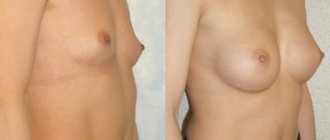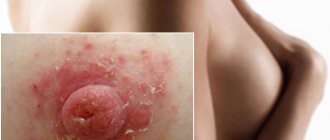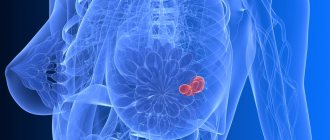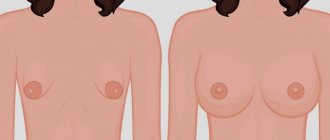How breasts change
The changes may vary in intensity for different women.
Some people's breasts swell instantly. Others note that bust enlargement during pregnancy occurs gradually. Some people see changes from the first weeks, while others until the last trimester note that their glands remain the same as before pregnancy. There are no hard and fast rules for such a “first sign” of pregnancy as the appearance of increased sensitivity in the nipples - sometimes it occurs as early as 3–7 days after conception, and in some women such a symptom appears only towards the end of the first trimester. It is important to take this fact into account and understand that the periods indicated later in the article are averages.
In the first trimester
The first trimester is 13 obstetric weeks. The countdown does not start from the moment of conception, but from the first day of the last menstrual cycle, during which fertilization occurred. For example, the first week from the beginning of pregnancy in obstetrics can be considered both the first and third weeks - the woman will have to remember the last time “things” went well for her.
In the early stages of pregnancy (in the first days after conception), no pronounced signs are observed. The breasts swell quite a bit, a slight pain occurs in the nipples - all this often occurs in women during PMS.
The pregnant woman begins to feel more or less noticeable changes at week 5, when the egg becomes a full-fledged embryo and is actively developing (a small heart is already forming). All this is accompanied by a hormonal surge in a woman’s body. It is at this time that the main mechanisms for changing the mammary glands are launched.
At week 6, there is a rush of blood to the areolas (because of this they darken), the breasts become more sensitive than usual (some people cannot touch the glands because of the pain, others’ nipples do not hurt, but only constantly itch). A local increase in temperature is possible (the décolleté area seems hot).
At week 8, the level of the hormone estrogen, which is responsible for the formation of glandular breast tissue, increases significantly. The total body weight increases, the mammary glands swell (become more rounded, hard and heavy).
At week 9, intensive breast growth continues. At 10 weeks, a venous network often appears - this is normal. The proliferation of glandular tissue stretches the skin, it becomes more transparent, and the vessels fill with blood more intensely, which makes them more noticeable. There is no need to worry - you can look at photos of pregnant women and women who have given birth (“the blue cobweb” after childbirth becomes paler and gradually disappears).
At week 11, you should pay attention to the size of your nipples. By this time they should already be fairly swollen. If growth does not occur, then feeding the baby will be difficult in the future. In the first months, the situation can be corrected by using correctors (for example, Avvent Niplett).
At week 12, it is recommended to introduce a daily habit of using different creams to maintain the elasticity of the breast skin. The fact is that from this moment on, the risk of developing stretch marks increases. If you do not take care of your bust in the first weeks of pregnancy, then it will be difficult to get rid of unsightly stripes on the glands.
In the second trimester
At week 13, there is an active change in the glandular tissue of the breast. Externally, no special changes are observed, but inside the alveolar sacs enlarge and become covered with acinar cells, which will produce milk after childbirth.
At 14 weeks, most pregnant women develop an oily, clear fluid from their nipples, which protects the nipples and areolas from cracking or drying out. At week 15, yellowish discharge begins to appear. This colostrum is a precursor to milk, which will be produced throughout the rest of the pregnancy and the first days after birth.
Usually, in the first trimesters, women make do with classic underwear, but already at the 17th week they definitely cannot do without a special bra for pregnant women. The breathable material helps to avoid diaper rash and nipple chafing, and the special supportive design will prevent unnecessary stress on the back.
In the third trimester
In the last weeks of pregnancy, your breasts are still changing. At this point, it becomes 1-2 sizes larger than before conception. But even if the bust is not very rounded, it always becomes heavier (due to the changed tissue structure of the mammary glands). More and more colostrum is released and it becomes thicker (looks similar to breast milk).
If in the third trimester fluid from the nipples is released too intensely, you need to use special bra pads. For example, Hartmann, Helen Harper, Lansinoh, Balla Mama inserts are suitable for pregnant women.
Why do breasts start to grow?
Breast growth is associated with an increase in the concentration of the hormones prolactin, estrogen and progesterone. The amount of these biologically active substances in the blood increases greatly after fertilization has occurred. The restructuring of the activities of all organ systems begins. Their work is subject to the requirements of the organisms of a pregnant woman and the unborn child.
Progesterone causes increased division of glandular epithelial cells. As a result, the volume of the alveolar cavity increases. The number of milk alveoli also increases. The number of milk lobes, which include the alveoli, is added. These changes ensure normal milk production during lactation. As the number of alveoli multiplies, the connective tissue that surrounds them also grows.
Estrogen stimulates the division of milk duct cells. This leads to an increase in the lumen in them and guarantees a greater speed of milk transportation. The mammotropic hormone prolactin is responsible for increasing the number of ducts. Its presence causes the formation and accumulation of colostrum. All this leads to proliferation of breast tissue.
Breasts that have stopped growing after the first trimester begin to grow again at the end of pregnancy. The secretion of colostrum increases and its transformation into mature milk begins.
All changes in the structure of the mammary gland are accompanied by an increase in the mass of subcutaneous fat deposits that surround the body of the gland. The proliferation of tissues leads to the fact that the breasts increase in size.
Norm
Questions about whether the changes occurring in the breast are normal or not always worry pregnant women. It is better to discuss any doubts with a doctor, since only a thorough medical examination can identify any anomaly. But excessive panic will not lead to any good (nervousness has a bad effect on the development of the fetus). You definitely don't have to worry about:
- mild pain and tenderness in the chest;
- clear and yellowish discharge from the nipples;
- swelling of the glands (both breasts will not necessarily grow equally, slight asymmetry is possible);
- venous network on the chest;
- enlargement and darkening of the nipples and areolas.
By the way, during the second pregnancy, the breasts do not change as much as during the first. Enlargement of the glands occurs according to the same pattern, but only a few experience pain (and even then only at the beginning, in the first trimester).
When should breasts start growing?
The first changes occur within a few days after fertilization. When the pregnancy reaches 1 week, the zygote enters the uterine cavity and attaches to its wall. A chorion is formed, which, together with the placenta, releases the first pregnancy hormones into the blood. They stimulate the division of glandular epithelium.
Once in the bloodstream, hCG reaches the pituitary gland. This is where the production of other hormones that regulate reproductive function begins. Therefore, changes become clearly visible only after 1 month. By this time, breast size may already increase by 1 size, and approximately 100–200 g are added to the mass of the glands.
By the end of the first trimester, the breasts may differ from the original by 3 sizes. Iron reaches its maximum levels during the period of preparation for labor, because this should be followed by breastfeeding. All morphological changes are individual and depend on the following factors:
- general condition of the body during pregnancy;
- body type;
- hereditary characteristics.
If the breasts do not grow in the first trimester or their growth is insignificant, this does not necessarily indicate a deviation. Its size can change greatly when the lactation period begins.
Major changes
Breasts change differently for each woman during gestation. This physiological and hormonal process depends on the individual characteristics of the expectant mother. The timing when breasts begin to grow during pregnancy also varies.
| Period, week of pregnancy | Changes |
| Fifth | There is pain and increased sensitivity. The chest fills up and becomes tense. Even a light touch causes discomfort |
| Twelfth | The shape and shade of the nipples change. The peripapillary circumferences darken and slightly increase in size. The nipples become prominent and have small nodules called Montgomery tubercles. According to experts, they perform the following functions:
Tubercles are always present on women's nipples, but become noticeable during breastfeeding. They disappear after the end of lactation |
| Sixteenth | There is an increase in the mammary glands by one to three sizes. Stretch marks appear on the chest. Their occurrence is due to the fact that the collagen fibers of the connective tissue cannot withstand a sharp increase and form red stripes on the surface of the skin. Their appearance does not depend on the degree of breast enlargement, but on the elasticity of the skin. Over time, stretch marks fade and become less noticeable. |
| Sixteenth-eighteenth | A vein network may appear on the chest |
| Twenty-four | Colostrum appears, which leaves yellowish spots on the bra. In some cases, it may appear as early as the fifteenth week or, conversely, later – at the thirtieth. Colostrum is a clear liquid that is a precursor to milk. It is released in small drops and does not cause physical discomfort. This liquid contains more nutrients and beneficial antibodies than milk |
Breasts before and after pregnancy
Experts have noticed that discomfort in pregnant women occurs in the early stages. At the fourteenth week they disappear, as during this time the tissues get used to sudden changes in hormone levels. At the tenth week, major changes occur in the mammary glands, and the preparation process begins to decline. At the twelfth week, the female bust is ready for a new stage, which will begin after the birth of the child.
There is no need to worry if your breasts stop hurting in the third month. All described changes occur individually. If a pregnant woman does not observe these changes in herself, this does not mean that there are serious abnormalities in her body.
To better understand what pregnant women’s breasts should look like, here are a few reviews from women who have given birth. From them it is clear that the body behaves slightly differently in different people.
“I gave birth twice. During my first pregnancy, my breasts hurt only during toxicosis, and then I didn’t notice any discomfort. The bust has increased by 1.5 sizes. During my second pregnancy there was no pain at all.”
Anastasia, 32 years old
“I’m about 6 weeks pregnant (obstetric) and my breasts haven’t changed at all. There is no increase - it remains the same as the first size. The nipples are also in the same condition. It's a little itchy, but I've always had that with PMS. The doctor calms me down and says that this is a feature of my body – by the 12th week changes will definitely begin.”
Anya, 28 years old
“My breasts began to ache only at 9 weeks of pregnancy. There were noticeable increases in size only from the last trimester - and then I observed them myself, but those around me said that everything was the same.”
Tatyana, 31 years old
“My breasts ached throughout the pregnancy and grew by about one size. The colostrum came only at 20 weeks (not much, so I didn’t even use inserts). After the completion of breastfeeding, the breasts instantly sank.”
Evgeniya, 35 years old
Preparing your breasts for pregnancy
All girls want well-groomed and beautiful breasts. To ensure that changes in the glands do not come as a shock to you, you should follow several rules:
- Buy a quality, comfortable bra. It should be wireless and have fairly wide straps. It is important that it does not constrain or squeeze it, as this will impede development and necessary growth.
- A daily contrast shower contributes well to an abundant flow of blood and the development of lobules. Showering also helps strengthen the nipples and the skin around them. You can use wiping with damp towels.
- Daily use of creams and oils. The components will help avoid the appearance of unwanted stretch marks.
- Strengthening the back and abdominal muscles. It will help when the fetus gains several kilograms and you don’t have the question: “why does your back hurt?
Will breasts retain their shape during pregnancy if I stop breastfeeding? No, since the process of changing its shape occurs even before the birth of the child. Milk is an important component for the growth and development of a baby, therefore it is extremely undesirable to refuse natural feeding to a child due to aesthetic preferences.
When to be wary
The above describes normal changes in the breasts of pregnant women. But there are deviations that should certainly alert a woman and become a reason to see a doctor:
- Blood from nipples. It may be a sign of wounds (tissues swell and skin cracks due to dryness). It also happens with tumors in the glands.
- Palpable lumps in the chest. This could be a cyst, galactocele, fibroadenoma, or malignant neoplasm.
- Nipple retraction with general breast enlargement. This is an alarming signal, as in most cases it indicates cancer.
Unfortunately, many diseases can worsen during pregnancy due to a hormonal surge and increased stress on the body. Women should be attentive to themselves and go to the hospital if alarming signals appear. Any delay threatens the exacerbation of pathologies that threaten the lives of both mother and child.











